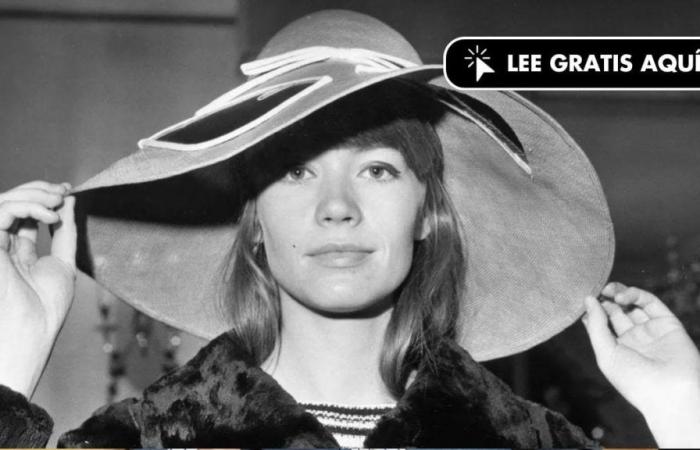“My past disappears and I make room for silence.” With these verses the poem ends Notre friincluded in the book Derniers poèmes d’amour (1963) Paul Eluard. And with these same verses he wanted to say goodbye, a few days ago, the photographer Jean-Marie Périer to the one who was his girlfriend and his muse in the 60s, Françoise Hardydied on June 11 at the age of 80 after a long illness.
While Lennon, Jagger or Dylan dreamed of seducing this pizpireta young girl who had become a legend after playing All the garçons and the girls (1962) on French television the night when Georges Pompidou won the legislative elections, the former assistant to Daniel Filipacchi and founder of the musical magazine Salut the copains! He maintained a romantic relationship with her, while teaching her how to pose for coated paper.
“Françoise hated being photographed and was not aware of her beauty. “I have never seen a more attractive person,” the photographer recalled in a 2013 interview. Both had in common a family past that tormented them: he, the singer’s illegitimate son Henri Salvador and the actress Jacqueline Porel, did not meet his true parent until adulthood; She was the daughter of a single mother and with a father who scared her every night when she showed up without warning, violently kicking the door and failing to get in.
Françoise herself recounted it without embellishment in her stark memoirs. Le désespoir des singes et autres bagatelles (2008), in which he decided to reveal – more for therapy than revenge – many hard moments in his biography: from the schizophrenia and suicidal tendencies of his sister Michèle to his complicated emotional relationships with a partner and later husband (the dandy skull Jaques Dutronc) who deceived her for decades and came to call her a frigid. And then someone will wonder why this girl sang such sad songs…
“To Françoise Hardy / on the bank of the Seine / a giant shadow of Notre-Dame / tries to grab my foot / students of the Sorbonne
They pass by on thin bicycles,” he wrote. Bob Dylan in its Poem Nº2 included in the booklet Another Side of Bob Dylan (1964). Our protagonist already had quite a few successes under her belt (Le premier bonheur du jour, Je n’attends plus personne, Mon amie la rose, Ce petit coeur, La maison oú j’ai grandi, Peut-être que je t’aime…), all in the key of taciturn or afflicted pop, but the author of Blowin’ in the Wind He had noticed her when he saw her in Paris-Match photographed by Périer and dressed in a suggestive steel sheet suit signed by Paco Rabanne. In May 1966, excited to meet her, he agreed to perform at the Sala Olympia, but that meeting was somewhat dull, with the two of them looking at each other out of the corner of their eye and almost not speaking. So the singer-songwriter ended up going to burn up the Parisian night in Johnny Hallyday’s convertible.
As for Périer, his melancholic girlfriend gave him a ticket shortly after, after falling in love with Jacques Dutronc, attractive artistic director of the Vogue record company, where the girl recorded, and who had written the hit for her The times of love. To say goodbye to the photographer, Françoise composed Comment will I say goodbye to you? (1968), a languid half-time show where she questioned the best way to break up with her boyfriend.
The origin of this theme was a standard of the Americans Arnold Goland and Jack Goldtitled It Hurts to Say Goodbye, which he had liked because it was catchy. In the middle of their separation and unable to translate the lyrics, his agent Lionel Roc suggested entrusting it to Serge Gainsbourg, a rising lyricist and composer who at that time was having an affair with Brigitte Bardot. In the same lot, Gainsbarre offered him an unreleased song, L’Anamourwhich she would also include in that ninth studio album, considered one of the greatest milestones of her career.
The entire album seemed like a hymn to heartbreak, with a track-list made up of versions of Phil Ochs, Tom Jobim, Ricky Nelson (Lonesome Town), Leonard Cohen (Suzanne)some cuts of his own authorship and a review of the Il n’y a pas d’amour heureux, legendary poem by Louis Aragon, set to music in 1953 by the great Georges Brassens. However, Françoise seemed to have found her better half in the aforementioned Jacques Dutronc, who slept with her the first time to win a bet and continued to act as an elusive boyfriend, always willing to exchange her for a night of partying with his colleagues. her.
Poor Françoise! In their loving swings had the best inspiration for that immortal repertoire, made up of afflicted mid-tempos and nostalgic ballads alluding to childhood, which would end up becoming the sentimental soundtrack of that France that was experiencing a time of prosperity under the mandate of General De Gaulle.
As the spearhead of that generation of French singers (France Gall, Sylvie Vartan…) who cultivated a fragile and innocent sex appeal, she had all of Paris at her feet, serving as a model for couturiers legends such as André Courrèges, Yves Saint Laurent or the aforementioned Rabanne, and even acting in films by Roger Vadim, Clive Donner, Jean-Luc Godard and John Frankenheimer. But his thing wasn’t the worldly parties, but all those songs that seem to have been written in the solitude of an empty house while it’s getting dark and raining outside.
That genuine formula of hyper-sensitive and almost tearful vocalization would end up artistically influencing many languid singer-songwriters of later decades. An attractive (and lucrative) sub-genre, recently described by Lucy Morgan in the British edition of the magazine Glamorlike that of sad girls.
“Just as there are movies to cry about, there are, obviously, songs that you want to listen to in the worst moments. The playlist of the sad girl provides a soundtrack to her breakups, her family arguments, her existential crises, her outbursts of nostalgia or loneliness and, many times, more than she would like, to Sunday afternoons,” explains Morgan. . “That playlist begins with the Joni Mitchell album with which Emma Thompson’s character retreats to her room to collapse in Love Actually and ends with the recognition of all the artists specializing in the genre who triumphed at the 2024 Grammy Awards. These are good times for poetry,” the article continues.
Without needing to go back to pioneers like Billie Holiday, Abbey Lincoln, Sheila Jordan, June Christy, Anne Phillips, Shiley Bassey or Helen Merrillthe sad girls most brilliant in the history of pop are undoubtedly inspired by the image of Audrey Hepburn singing Moon River in the film Breakfast with diamonds (1961), without forgetting professionals of retro anguish like Julie London (Cry Me a River1955), Brenda Lee (I’m Sorry1960), Patsy Cline (I Love You So Much It Hurts1961), Marianne Faithfull (As Tears Goes By1964), Peggy Lee (Me and My Shadow, 1969) or women singing in other languages such as the Brazilian Astrid Gilberto or the Italian Ornella Vanoni. But, above all, are the 30 studio albums that François Hardy recorded between 1962 and 2018, the sad and vulnerable girl par excellence.
Fans of the yeyé era always highlight his recordings from the 60s for the Vogue label as their golden era – and they are right – but I also like to claim works of maturity such as The question (1971) and Message personnel (1973) or more twilight albums like Le Danger (nineteen ninety six), Parentheses (2006) or The Pluie Sans Parapluis (2010). In all of them one perceives bitterness without self-pity, longing without sorrow, perhaps due to the fact of knowing that they were a legend in life, copied during the 21st century by enormous French women with brittle voices (Berry, Clarika, Elsa Kopf, Keren Ann, Coralie Clément, Mélanie Pain, Suzanne Lindon), claimed by Blur or Air – who called her to record with them – and even by our beloved Wes Anderson in an unforgettable scene from Moonrise Kingdom (2012).
Now that Françoise is gone, the admirers of the sad girl model will always have the complete discographies – in English, of course – of Nico, Joni Mitchell, Rickie Lee Jones, Patti Smith, Tracy Chapman, Lucinda Williams, Aimee Mann, Tori Amos, PJ Harvey, Fiona Apple, Cat Power and of course Lana del Reyto whom the new batches of devoted listeners of the sad girl music They idolize above anyone.
“I think that many female artists would not be where they are and would not have the inspiration that they have if it were not for the work that she has done,” Taylor Swift herself, a sad girl in every rule, saved by the mainstream and the stadiums. “I am a sad girl / I am a sad girl / I am a sad girl,” the aforementioned sang in the confessional song sad girlincluded in his essential album Ultraviolence (2014). And, in their footsteps, curious listeners can explore the platforms of streaming usual looking for the bittersweet pills made by new Anglo-Saxon stars like Mitski, Lucy Dacus or Phoebe Bridgers, who seem destined to contribute their badly wounded choruses to Sofia Coppola’s next film production.






